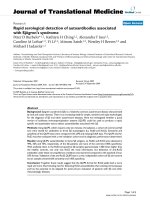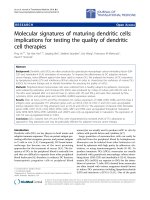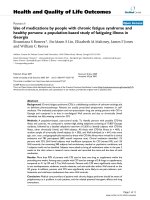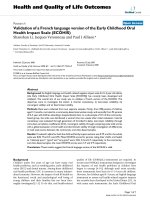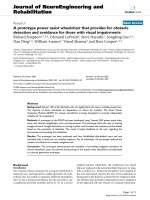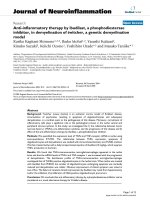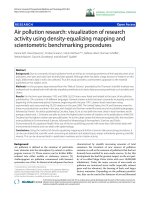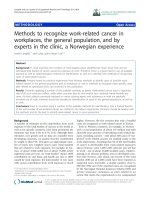báo cáo hóa học:" Optical Nerve Detection by Diffuse Reflectance Spectroscopy for Feedback Controlled Oral and Maxillofacial Laser Surgery" ppt
Bạn đang xem bản rút gọn của tài liệu. Xem và tải ngay bản đầy đủ của tài liệu tại đây (429.29 KB, 9 trang )
RESEARCH Open Access
Optical Nerve Detection by Diffuse Reflectance
Spectroscopy for Feedback Controlled Oral and
Maxillofacial Laser Surgery
Florian Stelzle
1*
, Azhar Zam
4
, Werner Adler
5
, Katja Tangermann-Gerk
2
, Alexandre Douplik
4
,
Emeka Nkenke
1
, Michael Schmidt
2,3
Abstract
Background: Laser surgery lacks haptic feedback, which is accompanied by the risk of iatrogenic nerve damage. It
was the aim of this study to investigate diffuse reflectance spectroscopy for tissue differentiation as the base of a
feedback control system to enhance nerve preservation in oral and maxillofacial laser surgery.
Methods: Diffuse reflectance spectra of nerve tissue, salivary gland and bone (8640 spectra) of the mid-facial
region of ex vivo domestic pigs were acquired in the wavelength range of 350-650 nm. Tissue differentiation was
performed using principal component (PC) analysis followed by linear discriminant analysis (LDA). Specificity and
sensitivity were calculated using receiver operating characteristic (ROC) analysis and the area under curve (AUC).
Results: Five PCs were found to be adequate for tissue differentiation with diffuse reflectance spectra using LDA.
Nerve tissue could be differed from bone as well as from salivary gland with AUC results of greater than 88%,
sensitivity of greater than 83% and specificity in excess of 78%.
Conclusions: Diffuse reflectance spectroscopy is an adequate technique for nerve identification in the vicinity of
bone and salivary gland. The results set the basis for a feedback system to prevent iatrogenic nerve damage when
performing oral and maxillofacial laser surgery.
Introduction
Laser surgery provides several advantages. Lasers allow
cutting biological tissue with high precision and minimal
trauma. Furthermore, the ability to work remotely
allows a high level of sterility [1-3]. However, these
advantages come along with a lack of feedback: the sur-
geon does not receive sufficient information about the
penetration depth of the laser cut or the type of tissue
being ablated at the bottom of the laser cut. Hence,
there is a risk of iatrogenic damage or the destruction of
anatomical structures such as peripheral nerves [4-6].
Oral and maxillofacial surgery in particular has to deal
with complex anatomy in the head and neck region,
including major sensory and motor nerves. Damaging
those can immensely affect function and aesthetics.
Two types of oral and maxillofacial surgeries are
known for having an inherent risk of iatrogenic nerve
damage, also in the case of conventional surgery techni-
ques: First of all, removing the parotid gland can be
accompanied by a damage of the facial nerve in 10 to
50% of cases. This leads to a temporary or permanent
ipsilateral facia l paralysis with an insufficient c losure of
eyelid and mouth [7,8]. Due to the fact that the
branches of the facial nerve run directly through the
parotid gland and both tissue types look very much
alike, it is not easy for the surgeon to reliably differenti-
ate the nerve from the gland. One opportunity for nerve
identification is electrical stimulation. However, iatro-
genic nerve damage could not eve n be significantly
reduced by using advanced techniques of intra-operative
neuromonitoring [9]. Secondly, orthognathic surgery
performs a sagittal split through the lower jaw to correct
the dental occlusion and the position of the mandible.
The surgery can cause lesions to the lower alveolar
* Correspondence:
1
Department of Oral and Maxillofacial Surgery, Erlangen University Hospital,
Erlangen, Germany
Full list of author information is available at the end of the article
Stelzle et al. Journal of Translational Medicine 2011, 9:20
/>© 2011 Stelzle et al; licensee BioMed Central Ltd. This is an Open Access article distributed under the terms of the Creative Commons
Attribution Licens e ( nses/by/2.0), which pe rmits unrestricted use, distribution, and reproduction in
any medium, provided the original work is properly cited.
nerve in 13 to 83% of the cases, with temporary or per-
manent numbness of the equilateral half of the lower lip
and chin [10], which can hamper ingestion and speech
production: The lower alveolar nerve runs through the
mandible hidden in a bony canal. Conse quently, cutting
the bone has to be performed using specialized surgical
techniques without a direct view on the nerve.
To benefit from laser cutting in oral and maxillofacial
surgery and to simultaneously reduce iatrogenic nerve
damage in the facial region, additional means are
required that will automatically control the laser abla-
tion through intra-operative nerve detection. Concerning
the two surgeries mentioned above, there is to differ-
entiate betw een nerves and salivary gland tissue as well
as betwee n nerves and bone. Several approache s for tis-
sue specific laser ablation control using optical feedback
systems have been described [11-13]. The basic idea is
to regulate the laser ablation using optical tissue differ-
entiation and to stop the laser cut when it reaches the
vicinity of nerve tissue.
Diffuse Reflectance Spectroscopy (DRS) provides a
relatively simple and cost-effective approach for tissue
differentiation. The light applied is absorbed or scat-
tered, depending on the optical properties of each tissue
type. In the visible range, the main tissue absorbers are
melanin and hemoglobin [14], and the main tissue scat-
terers are cell organelles (such as mitochondria, etc.)
and cells [14]. Several types of normal healthy tissues
from animals and humans have been described in terms
of their optical properties by means of diffuse reflec-
tance spectra ex vivo [15-17] and in vivo [18]. However,
there is little information about the differentiation
between different types of healthy tissue so far. Recently,
the general feasability of optical tissue differentiation by
a remote diffuse reflectance spectroscopy set up could
be shown by our work group [19].
The goal of this study was t o apply this diffuse reflec-
tancespectroscopytechniqueonthedifferentiation
between nerves and salivary gland tissue as well as
between nerves and hard tissue. The differentiation
between these tissue types is challenging due to their
bioptic similarity. Also , it is highly relevant concerning
the clinical application in the facial region, evolving the
mentioned prior research and expanding it towards a
clinical problem solution. The experiments deliver a
basis for developing a remote optical nerve detection to
control the surgical laser cut, with the intent of nerve
preservation in oral and maxillofacial surgery.
Materials and met hods
Tissue Samples
Four types of tissue - nerves, salivary glands, cancello us
bone and corti cal bone - were taken from 12 bisected
ex vivo domestic pig heads (48 tissue samples).
Nerve tissue samples were taken from the infraorbital
nerve, salivary gland tissue was taken from the external
part of the parotid gland and cancellous and cortical
bone from the lower jaw in the region of the premolars.
Hard tissue samples were cut with a water-cooled micro
jigsaw, soft tissue samples were dissected using a scalpel.
The bone and salivary gland tissue samples measured
5 × 5 cm with a thickness of 1 cm on av erage. The
nerve tissue was provided with the perineural sheath
and had a length of 5 cm and a diameter of 1 cm on
average. After dissection, the tissue samples were care-
fully washed with a sterile saline solution to remove all
superficial contamination, including clotted blood parti-
cles. We refrained from other cleaning methods, e.g.
mechanical cleaning, to avoid alteration of the tissue
samples. Until they were measured, the tissue samples
were slightly moistened with a sterile saline solution and
stored in a sealed box to avoid optical changes due to
desiccation. All tissue samples were excised an d mea-
sured on the day of slaughter within a maximum ex vivo
time of 6 hours. Dissection, storage and measurement s
were conducted under a constant room temperature
(22°C). There was no local or systemic illness of the
animals to cause any pathological tissue alterations prior
to sample extraction.
Experimental Setup
The diffuse reflectance o f the tissues was measured ex
vivo using a reflection/backscattering probe QR600-7-
SR-125F
®
(Ocean Optics, USA). The experimental setup
shown in Figure 1 consisted of a Pulsed Xenon lamp
PX-2
®
(Ocean Optics, USA) projected onto tissue via
the reflection/backscattering probe, and a high resolu-
tion spectrometer HR4000
®
(Ocean Optics, USA) with a
1.1 nm optical resolution. The spectrometer has a
dynamic range of 25 dB S/N and 31 dB. The spectro-
meter’ s accuracy is greater than 99%. The reflection/
backscattering probe consists of 6 illumination fibers
and a single collection fiber. Each optical fiber has a
600 μm core diameter and a 0.22 numerical aperture.
The diffuse reflectance measurement was acquired
within 10 ms of integration time. All tissue samples
(12 tissue samples per tissue type) were placed and mea-
sured at a distance of 1 cm from the distal end of the
probe. For each tissue sample, 6 different spots were
chosen with a distance of 0.5 cm from each other. Per
spot, 30 diffuse reflectance spectra were acquired
(180 spectra per tissue sample). In total, 2160 diffuse
reflectance spectra were acquired for each of the four
types of tissue investigated.
The measurements were conducted under consistent
conditions of minimized stray environmental light in the
laboratory, which allowed us to exploit the experimental
setup.
Stelzle et al. Journal of Translational Medicine 2011, 9:20
/>Page 2 of 9
Data Processing
The diffuse reflectance raw signal
S
R
d
()
collected was
converted into diffuse reflectance R
d
(l). The light source
emission spectrum reference spectrum was collected
using the reflectance standard WS-1
®
(250-1500 nm,
Ocean Optics, USA). The diffuse reflectance was calcu-
lated as follows:
RS SSS
dRdDRD
() () ()/ () () %
=− −⋅100
(1)
Where:
S
Rd
(l): Diffuse reflectance raw signal (a.u.).
S
R
(l): Light source emission spectrum reference (a.u.).
S
D
(l): Background signal (a.u.).
Due to high noise in the near in frared spectral region,
diffuse reflectance spectra beyond 650 nm were
excluded from consideration. The background signal S
D
(l) was used for the correction of stray light during
measurement. After pre-processing, the spectra con-
sisted of 1150 data points within the 350-650 nm range
(0.26 nm wavelength resolution).
Statistical analysis
We performed four consecutive steps for the statistical
analysis of the data set. First, we reduced the number of
variables using principal components analysis (PCA).
A multiclass linear discriminant analysis (LDA) was
trained with an appropriate number of principal compo-
nents in the second step and class probabilities of obser-
vations not used for training were predicted in a third
step. The last step included the calculation of the
optimal threshold as well as sensitivity and specificity
for tissue differentiation using receiver operating charac-
teristic analysis (ROC). Our data set consisted of
repeated measurements of only 48 specimens. Splitting
the data into learning and test d ata was therefore inap-
propriate. Thus, we reused the data for training and
testing by means of leave-one-out cross-validation,
meaning that we split the data into 48 parts, each part
consisting of all observations of a single specimen [20].
We then used 47 parts for calculating the PCA and
training the LDA and the re maining part for testing.
This was repeated for all 48 parts so that the predictions
for all observations in the data set were estimated.
Principal Components Analysis (PCA)
To reduce the numb er of predictor variables, we per-
formed a principal component analysis (PCA). In order to
optimize the classification performance, we standardized
and scaled the data: For each of the 1150 wavelength mea-
surement values the mean of all measurements (at each
specific wavelength) is subtracted from the measure-
ment value and the result is divided by the standard
deviation of all measurements (at each specific wave-
length). Thus, a mean value of zero and a standard
deviation of one were obtained for the measurements
on a wavelength-by-wavelength basis. The PCA per-
forms a decomposition of the data by creating orthogo-
nal and thereby independent linear combinations of the
variables, the so-called principal components (PC).
There are as many PCs as variables, but the advantage is
that only several are necessary to describe a large
amount of the v ariation of the data, while the majority
Figure 1 Schematic diagram of experimental setup for diffuse reflectance mea surement. (a) High resolution spectromet er HR4000
®
(1.1 nm optical resolution, Ocean Optics, USA), (b) Pulsed Xenon lamp PX-2
®
(220-750 nm, Ocean Optics, USA), (c) Reflection/backscattering
probe QR600-7-SR-125F
®
(600 μm core, NA = 0.22, Ocean Optics, USA), (d) Biological tissue (pig ex vivo).
Stelzle et al. Journal of Translational Medicine 2011, 9:20
/>Page 3 of 9
of the PCs’ is respo nsible for less than 1% of the scatter.
For our analysis, we used the first, second, fourth, fifth,
and ninth principal component for classification. These
principal components were determined: We performed
a leave-one-out cross-validation to estimate the classifi-
cation performance. In each cross-validation step, a
PCA was calculated and Mann-Whitney U-tests were
performed to test the discriminative power of each of
the PCs between any pairwise tissue comparisons. For
each of the pairwise comparisons, we selected those PCs
that lead to the three lowest p-values, so that a maxi-
mumof18PCswaschosenifnoneofthePCsdiscrimi-
nated well between more than two tissues (6 pairwise
comparisons) and a minimum of three PCs was chosen
if the same three PCs discriminated best between all tis-
sues. In the following steps we performed LDA t raining
and testing and ROC analysis. We found that in each of
the cross-validation steps, either nine o r ten different
PCs were selected, and that the first, second, fourth,
fifth and ninth component was always selected while the
remaining four or five selected components differed
between individual cross-validation steps. Following our
aim to build a classification method for practical use, we
chose to repeat the cross-validation without the adap-
tive selection of the principal components, as this is
prohibitive in a practical classification system. Instead,
we trained and tested the LDA with only those PCs that
were selected in each of the steps.
Classification
We utilized multiclass linear discriminant analysis
(LDA) to separate the data (the five chosen principal
components) with respect to their class membership,
i.e., the tissue types [21]. Linear discriminant analysis is
a method used to produce a discrimination rule that
maximizes the ratio of interclass variance to intra-class
variance of the observations. Instead of calculating fixed
class m emberships, we evaluated the class probabilities
of each observation with respect to their inclusion as
one of the four tissues.
Receiver Operating Characteristic (ROC) Analysis
The classification performa nce based on the estimated
class probabilities was evaluated using receiver operating
characteristic (ROC) analysis [22] with pairwise compar-
isons of all tissues: We calculated sensitivities and speci-
ficities for the optimal cutpoint maximizing the Youden
index [23] which is defined as sensitivity + specific ity - 1.
This is the point with the largest distanc e to the diagonal
and consequently is the optimal point of the ROC curve
if sensitivity and specificity are of equal importance and
without an existing restriction, e.g., a minimum specifi-
city. Furthermore, we provided areas under the ROC
curve (AUC).
The entire statistical analysis was carried out using the
programming language R [24].
Results
The average spectra of diffuse reflectance in the wave-
length range between 350 and 650 nm from the four
types of tissue investigated in this study are shown in
Figure 2 and in a normalized version in Figure 3. The 5
principal components (PCs) that were selected for classi-
fication w ere responsible for 97.34% of the variation of
the da ta. The first PC do es not show remarkable peaks
and describes 88.06% of the variance of the diffuse
reflectance spectra. PC 2 shows prominent peaks at
540 nm and 580 nm, PC 4 shows prominent peaks at
410 nm, 540 nm and 580 nm (Figure 4), but contributes
only to 8.52% (PC 2) and 0.65% (PC 4) of the optical
variance of the types of tissue. St arting with the fourth
PC, chosen fo r the tis sue differentiation (PC 5 and 9),
the curves get more disturbed by the influence of noise.
ROC analysis showed that PCA, followed by LDA,
could differentiate between nervetissueandsalivary
gland or osseous tissue types, respectively, with AUC
results of 0.88 to 1.00 in this study (Table 1, Figure 5).
Concerning the sensitivity of differentiation between
nerve tissue and hard tissue, the result was more than
90% for ca ncellous bone and 83% for cortical bone. The
sensitivity of differentiation between nerve tissue and
salivary gland tissue reached over 90% (Table 1). T he
specificity of tissue differentiation reached over 75% in
all cases (Table 1).
Discussion
For feedback controlled laser surgery, tissue differentia-
tion is a crucial step. Especially in oral and maxillofacial
Figure 2 Non-standardized diffuse reflectance spectra for
different hard and soft tissues.
Stelzle et al. Journal of Translational Medicine 2011, 9:20
/>Page 4 of 9
surgery, the identification of major peripheral nerves is
essential to avoid iatrogenic damage to these anatomical
structures. Laser light may destroy n eural structures
through direct ablation or overheating due to laser
cutting of adjacent tissue. Both can lead to reduced or
missing nerve function [4-6].
In order to create the basis for optical nerve identifica-
tion, we extracted diffuse reflectance spectra of 4 differ-
ent types of tissue, i.e., nerve tissue, salivary gland
tissue, cortical bone and cancellous bone from ex vivo
pig samples. The selection of tissue types followed a
clinical approach. Chosen were the tissue types which
can be found on two typical oral and maxillofacial
operations with a high risk of iatrogenic nerve damage:
surgeries on the parotid gland jeopardize the facial
Figure 4 PC loading. PC 1 has a consistent contribution of loading
along the investigated wavelength range; PC 2 and PC 4 show a
higher variation of loading with prominent peaks at 410, 540 and
580 nm; PC 5 and 9 are more disturbed by the influence of noise
(not shown in the figure).
Table 1 AUC, Sensitivity and Specificity of tissue
differentiation
Cortical bone Nerve Salivary Gland
AUC
Nerve 0.888
Salivary Gland 0.894 0.944
Cancellous bone 0.973 0.988 1.000
Sensitivity
Nerve 0.837
Salivary Gland 0.835 0.931
Cancellous bone 0.913 0.919 1.000
Specificity
Nerve 0.788
Salivary Gland 0.808 0.844
Cancellous bone 0.985 1.000 1.000
Figure 5 ROC curve for compari son between nerve and
salivary gland tissue (as example for the ROC-curves derived
from the data analysis).
Figure 3 Standardized diffuse reflectance spectra for different
hard and soft tissues (Transformation of the entire data set
using a mean of zero and a standard deviation of 1).
Stelzle et al. Journal of Translational Medicine 2011, 9:20
/>Page 5 of 9
nerve; orthognathic surgery on the lower jaw jeopardizes
the lower alveolar nerve. To keep the experiments
straightforward, only tissues in direct anatomical contact
with the pa rticu lar nerves were chosen for optical tissue
differentiation. Fi ve branches of the facial n erve go
directly through the parotid gland and are fully sur-
rounded by salivary gland tissue in the p re-auricular
region [25]. The lower alveolar nerve runs through a
mandibular canal and is directly surrounded by a bony
canal. It is therefore surrounded by bone structure con-
sisting of thin cortical bone. In rare cases of reduced or
missing cortical bone the nerve may be directly sur-
rounded by cancellous bone [26].
As the averaged spectra of the four tissues turned out
not to be too distinct, advanced methods of analysis
were used to differentiat e the spectral curves. Analyzing
the principal components of the spectra, we found 5
PCs that contributed significantly to the differentiation
of the four types of tissue. These PCs were consistently
chosen in all cross validation steps. PC 1 is responsible
for more than 85% of the variance of the diffuse reflec-
tance spectra derived from the fo ur tissue types. For PC
1, the results of the PCA demonstrated a consistent
contribution along the investigated wavelength range,
without any remarkable peaks. PC 2 and PC 4 demon-
strated prominent peaks at 410, 540 and 580 nm, which
are meant to be related to the peaks of oxyhemoglobin
and deoxyhemoglobin (Figure 4). Consequently, it is
assumedthatPC1providedinformationaboutthe
absorption/scattering contribution other than blood.
This means t hat PC 1 can basically repre sent the bio-
morphological variety of the tissues, such as size and
number of cells and cell nuclei, cell organelles (e.g.
mitochondria) and the amount and dens ity of the extra-
cellular matrix (E CM) including collagen. All of these
are known to contribu te to overall amo unts of diffuse
reflectance apart from blood [27-29]. The shape of the
curve of PC 2 and PC 4 is similar to the spectral shape
of blood, reflecting the contribution of blood absorption,
reflection and backsc attering in the visible range [30].
However, compared to PC 1, PC 2 and PC 4 are com-
monly responsible for only 9% of the variance between
the reflectance spectra of different types of tissue.
Regarding the AUC results of the tissue differentia-
tion, nerve tissue could be identified with a probability
of 88.8% to 100%. The best result could be determined
between salivary gland tissue and cancellous bone. How-
ever, it was not the major goal of this s tudy to differ-
entiate between these tissue types. The differentiation
between nerves and cancellous bone reached high values
of 98.8%. The lowest value was found for the differentia-
tion between nerves and cortical bone (88.8%). An
exclusively pairwise differentiation of tissue types may
have yielded even better results. However, a pairwise
differentiation of known tissue types does not meet the
requirements of a clinical application w ith potential
inter-individual variations of anatomy. Therefore, we
chose a more complex mathematical approach implicat-
ing a multiclass analysis.
A high rate of correct tissue differentiation is only one
part of nerve identification and preservation. The crucial
step prior to a transfer of the technique to a clinical
application may be the sensitivity of tissue differentia-
tion. In this st udy, the sensitivity of nerve differentiation
was found to be rather high with values ranging
between 83.5% - 100%. The lowest result was achieved
for the differentiation between cortical bone and salivary
gland. However, the differentiation of that ti ssue pair
was not a major goal of this study which focused on
nerve tissue according to the clinical approach. A high
sensitiv ity with over 90% could be demonstrated for the
differentiation between nerves and cancellous bone as
well as between nerves and salivary gland tissue. The
differentiation of both tissue pairs is of h igh relevance
considering clinical conditions. A similarly high result
was achieved for the tissue pair nerves and cancellous
bone yielding a specificity of tissue differentiation of
100%. The specif icity of tissue differentiation between
nerves and salivary gland tissue demonstrated only 84%,
between nerves and cortical bone only 78%. However, a
reduced specificity may be tolerated in favor of a high
sensitivity if the aim is a precise and reliable preserva-
tion of major nerves. Additionally, a specificity of more
than 70% may still allow for an uncomplicated perfor-
mance in a clinical set-up.
Although it was not t he goal o f this study to investi-
gate the differing optical prope rties of tissues, the differ-
ences of optical spectra may be explained by some
considerations based on the simila rity or the di versity of
anatomical and bioche mical structures: The single nerve
fiber of peripheral nerves, like the infra-orbital nerve, is
surrounded by a myelin sheath that contains 75% lipids
(25% cholesterol, 20% galactocerebroside, 5% gala ctosul-
fatide, 50% phospholipids). Salivary gland tissue of
humans and other mammals c onsist s of epithe lial cells,
fibrousconnectivetissueandahighpercentageoffat
cells with 25% of volume on average [31]. The percen-
tage of fat increases with age and can reach up to 60%
of volume [32]. Lipocytes, t he major cell population of
fat tissue, predominantly consist of lipids. The com-
pounds are triglycerides, cholesterol and other fatty
acids[33].Itisassumedthatthehighproportionof
lipids of both tissue types - salivary gland and the mye -
lin sheath of peripheral nerves - leads to a similarity of
optical properties, followed by a reduction of optical
contrast of the derived diffuse reflectance spectra.
Bone tissue consists of 65% inorganic elements (cal-
cium phosphate compounds, mainly hydroxyapatite
Stelzle et al. Journal of Translational Medicine 2011, 9:20
/>Page 6 of 9
[CA
10
(PO
4
)
6
(OH)
2
]) and 35% organic elements (col-
lagen fibers, water, proteins). Cancellous bone demon-
strates a porosity with an average of 80%, due to the
intertrabecular marrow spaces [34]. Only 20% of the
cancellous bone volume is built of bone tissue forming
an osseous scaffold. The interspace of the osseous scaf-
fold is filled with bone marrow. In adolescent beings,
like the animals used in this stu dy, the bone marrow is
involved in the hematopoesis. Hence, it is highly vascu-
lar and mainly consists of hematopoietic cells and ery-
throcytes [35]. Therefore, the main optical properties of
the cancellous bone are assumed to be constituted by
hem oglobin and the hematop oietic cells. This may even
be the case under ex vivo conditions, due to the fact
that blood cells are fixed in the osseous scaffold of the
cancellous bone. The fixation prevents the cells from
descending to deeper tissue layers through gravity after
circulatory arrest. After adolescence, aging is followed
by a reduction of hematopoietic cells replaced by fat
cells - indicating the transiti on from red to yellow bone
marrow. Yellow bone marrow can contain an amount of
fat cells of u p to 80% [36]. That has to be kept in mind
concerning a transition of the results to clinical condi-
tions involving mature human beings.
Cortical bone demonstrates a very dense and homoge-
neous structure with a porosity of only 3.5% on average
[34]. Therefore, the main optical properties of cortical
bone are assumed to be constituted by the inorganic
elements calcium and phosphate. In contrast, the
reduced tissue differentiation between nerves and corti-
cal bone does not reflect the biological diversity of the
two tissue types. One possible explanation may be the
reduced blood content of both tissues under ex vivo
conditions, considering the fact that blood is known to
be one major optical absorber and reflector of biological
tissue [37]. Different types of tissue demonstrate differ-
ent degrees of blood flow under in vivo conditions,
which may considerably change the diffuse reflectance
spectra [38]. In the presence of microcirculation, the
blood content of the myelin sheath is different from the
blood content of a salivary gland as well as of bone tis-
sue. We expect that the discrimination algorithm based
on diffuse reflectance spectra will work more reliably
in vivo [29,39]. However, the findings have to be evalu-
ated in further in vivo experiments.
For tissue differentiation a spectral range of 350-650
nm was used. Diffuse reflectance spectra over 650 nm
showed high noise. Hence, the infrared spec tral region
wasexcludedinthisstudy.Thehighnoisemaybea
result of the presence of a large number of emission
lines in the Xenon-lamp emission spectra or of the rela-
tively low intensity of our light source. Other light
sources, e.g., the tungsten halogen lamp, are known for
a smo oth emission profile showing favorable results for
diffuse reflectance spectroscopy measurements [40,41].
On the other hand, using the Xenon light source yielded
decent differentiation results providing sufficient inten-
sity around the 410 nm peak - a wavelength which
turned out to be o f value for the differentiation of the
tissue types investigated in this study. The results might
be different considering the influence of blood. Hence,
further research is necessary to investigate if the chosen
set up is sufficient for the differentiation of biological
tissue under in vivo conditions.
The results of this study were obtained using sepa-
rated tissue samples containing only one type of tissue.
One major challenge will be transferring the set up to a
compound tissu e sam ple which contains nerve tissue as
well as other tissue types. Associated with this challenge
is t he penetration depth of the applied light, inheriting
the possibility of optical spectra derived from several
types of tissues situated together in the interrogation
depth. Further research is necessary to establish a model
simulation of the optical pathw ays to analyze nerve
identification in biological tissue compounds.
In this study, we investigated tissue samples from
domestic pigs. Extrapolating the results to human tissue,
interspecies differences of optical tissue properties have
to be considered. Additionally, there may be an altera-
tion of optical tissue properties due to post mortem
changes. It is known that de-oxygenation and a loss of
hemoglobinarethemainfactorsforacontinuing
decrease of absorption in the visible wavelength range
during the first 24 hours post mortem [42]. Even if this
process slows down after the first 24 hours, a further
decrease of absorption may occur. To take the conti nu-
ing post mortem changes of absorption decrease at the
hemoglobin peaks into account, we kept the ex vivo
time for tissue preparation and measurements as short
as possible and, with 6 hours, equal for all the tissue
types investigated in this study. However, post mortem
changes may have altered the optical properties of the
tissue samples, influencing the diffuse reflectance
spectra.
A remote set-up was utilized for the measurements, to
take two factors into account. Light delivery or measure-
men t tools that are in direct contact with biological tis-
sue may cause an alteration of optical properties due to
a mechanical manipulation. The applied pressure on the
tissue causes increased tissue absorption and scatte ring
coefficients [43], which may alter the results of optical
tissue differentiation. In addition, considering the clini-
cal applica tion of optical tissue differentiation, it has to
be kept in mind that mechanical manipulation of the
tissue may cause the spreading of germs or tumor cells
during surgery [44,45]. Hence, focusing on a non-con-
tact set-up, the environmental light has to be excluded
as it may interfere with the optical spectra derived from
Stelzle et al. Journal of Translational Medicine 2011, 9:20
/>Page 7 of 9
the tissue. Executing the optical measurements in abso-
lute darkness is a well known possibility [29,46], but
does not meet the requirements for an uncomplicated
clinical application. Hence, the diffuse reflectance spec-
tra were mathematically corrected for environmental
stray light to increase the signal to noise ratio during
the measurements [47].
For a sufficient implementation of this tissue differen-
tiation technique in a closed loop system to control laser
ablation in surgery, the computational time required for
analyzing the reflectance spectra is essential. A first basic
feedback system was established with an acoustic sensor
by our workgroup showing the general feasibility of a
real-time sensor based control of laser surgery. The sys-
tem was limited to the differentiation of two bone quali-
ties [13,48]. Considering an expansion of the system
towards a general applicability, it will be necessary to
analyze several tissue types in a very short period of time
which may be a mathematical and computational chal-
lenge.However,thetimerequiredfortissuedifferentia-
tion was not the objective of our study. Before
transferring the results of this study to a control system,
this issue has to be investigated on further research.
Conclusions
The results of this study show the general possibility of
remote differentiation between nerve, salivary gland and
bone tissue types, using diffuse reflectance spectroscopy.
A control system can be established on the basis of this
technology, which will be able to identify nerve tissue
during oral and maxillofacial laser surgery to prevent
iatrogenic nerve damage when performing surgeries on
the parotid gland or the mandible. However, prior to
any clinical application, further experiments are neces-
sary t o investigate the influence o f blood microcircula-
tion in vivo, the carbonization zone from laser ablation
and/or bleeding on the surface o f surgical wounds on
diffuse reflectance tissue differentiation.
Ethics considerations
Not necessary. The experimental study was carried out
on tissues which were provided by a slaughterhouse.
Acknowledgements
The authors gratefully acknowledge funding by the ELAN-Funds, University
of Erlangen-Nuremberg and the Erlangen Graduate School in Advanced
Optical Technologies (SAOT) by the German National Science Foundation
(DFG) as part of the Excellence Initiative.
Author details
1
Department of Oral and Maxillofacial Surgery, Erlangen University Hospital,
Erlangen, Germany.
2
blz - Bavarian Laser Center, Erlangen, Germany.
3
Chair of
Photonic Technologies, Friedrich-Alexander-University of Erlangen-
Nuremberg, Erlangen, Germany.
4
SAOT - Graduate School in Advanced
Optical Technologies, Friedrich-Alexander University of Erlangen-Nuremberg,
Erlangen, Germany.
5
Department of Medical Informatics, Biometry and
Epidemiology, Friedrich-Alexander University of Erlangen-Nuremberg,
Erlangen, Germany.
Authors’ contributions
FS, AZ and KTG carried out the tissue preparation as well as the optical
measurements. AZ, AD and KTG installed and adapted the optical set-up.
WA participated in the design of the study and performed the statistical
analysis. FS, AD, EN and MS performed the data analysis and assessment. FS
and MS conceived of the study, participated in design and coordination and
drafted the manuscript. All authors read and approved the final manuscript.
Competing interests
The authors declare that they have no competing interests.
Received: 2 November 2010 Accepted: 10 February 2011
Published: 10 February 2011
References
1. Kuttenberger JJ, Stubinger S, Waibel A, Werner M, Klasing M, Ivanenko M,
Hering P, Von Rechenberg B, Sader R, Zeilhofer HF: Computer-guided CO2-
laser osteotomy of the sheep tibia: technical prerequisites and first
results. Photomed Laser Surg 2008, 26:129-136.
2. Stopp S, Svejdar D, von Kienlin E, Deppe H, Lueth TC: A new approach for
creating defined geometries by navigated laser ablation based on
volumetric 3-D data. IEEE Trans Biomed Eng 2008, 55:1872-1880.
3. Spinelli P, Calarco G, Mancini A, Ni XG: Operative colonoscopy in cancer
patients. Minim Invasive Ther Allied Technol 2006, 15:339-347.
4. Baxter GD, Walsh DM, Allen JM, Lowe AS, Bell AJ: Effects of low intensity
infrared laser irradiation upon conduction in the human median nerve
in vivo. Exp Physiol 1994, 79:227-234.
5. Menovsky T, van den Bergh Weerman M, Beek JF: Effect of CO2 milliwatt
laser on peripheral nerves: Part I. A dose-response study. Microsurgery
1996, 17:562-567.
6. Menovsky T, Van Den Bergh Weerman M, Beek JF: Effect of CO(2)-Milliwatt
laser on peripheral nerves: part II. A histological and functional study.
Microsurgery 2000, 20:150-155.
7. Marchesi M, Biffoni M, Trinchi S, Turriziani V, Campana FP: Facial nerve
function after parotidectomy for neoplasms with deep localization. Surg
Today 2006, 36:308-311.
8. Bron LP, O’Brien CJ: Facial nerve function after parotidectomy. Arch
Otolaryngol Head Neck Surg 1997, 123:1091-1096.
9. Garcia-Losarcos N, Gonzalez-Hidalgo M, Franco-Carcedo C, Poch-Broto J:
Electrical stimulation of the facial nerve with a prognostic function in
parotid surgery. Rev Neurol 2009, 49:119-122.
10. Colella G, Cannavale R, Vicidomini A, Lanza A: Neurosensory disturbance
of the inferior alveolar nerve after bilateral sagittal split osteotomy: a
systematic review. J Oral Maxillofac Surg 2007, 65:1707-1715.
11. Kim BM, Feit MD, Rubenchik AM, Mammini BM, Da Silva LB: Optical
feedback signal for ultrashort laser pulse ablation of tissue. Appl Surf Sci
1998, 127:857-862.
12. Deckelbaum LI, Desai SP, Kim C, Scott JJ: Evaluation of a fluorescence
feedback system for guidance of laser angioplasty. Lasers Surg Med 1995,
16:226-234.
13. Rupprecht S, Tangermann-Gerk K, Wiltfang J, Neukam FW, Schlegel A:
Sensor-based laser ablation for tissue specific cutting: an experimental
study. Lasers Med Sci 2004, 19:81-88.
14. Prasad PN: Bioimaging: Principles and techniques; Introduction to
Biophotonics, chapt 7. Hoboken. NJ, Wiley-Interscience; 2003.
15. Ebert DW, Roberts C, Farrar SK, Johnston WM, Litsky AS, Bertone AL:
Articular Cartilage Optical Properties in the Spectral Range 300-850 nm.
J
Biomed Opt 1998, 3:326.
16. Troy TL, Thennadil SN: Optical properties of human skin in the near
infrared wavelength range of 1000 to 2200 nm. J Biomed Opt 2001,
6:167-176.
17. Yaroslavsky AN, Schulze PC, Yaroslavsky IV, Schober R, Ulrich F,
Schwarzmaier HJ: Optical properties of selected native and coagulated
human brain tissues in vitro in the visible and near infrared spectral
range. Phys Med Biol 2002, 47:2059-2073.
18. Taroni P, Pifferi A, Torricelli A, Comelli D, Cubeddu R: In vivo absorption
and scattering spectroscopy of biological tissues. Photochem Photobiol Sci
2003, 2:124-129.
Stelzle et al. Journal of Translational Medicine 2011, 9:20
/>Page 8 of 9
19. Stelzle F T-GK, Adler W, Zam A, Schmidt M, Douplik A, Nkenke E: Diffuse
Reflectance Spectroscopy for Optical Soft Tissue Differentiation as
Remote Feedback Control for Tissue-Specific Laser Surgery. Lasers Surg
Med 2010, 42:319-325.
20. Brenning A, Lausen B: Estimating error rates in the classification of paired
organs. Stat Med 2008, 27:4515-4531.
21. Hastie T, Tibshirani R, Friedman J: The elements of statistical learning.
Springer New York; 2001.
22. Fawcett T: An introduction to ROC analysis. Pattern recogn lett 2006,
27:861-874.
23. Youden WJ: Index for rating diagnostic tests. Cancer 1950, 3:32-35.
24. Team RDC: R: A language and environment for statistical computing. R
Foundation for Statistical Computing; Vienna, Austria 2008 [http://www.R-
project.org].
25. Raghavan P, Mukherjee S, Phillips CD: Imaging of the facial nerve.
Neuroimaging Clin N Am 2009, 19:407-425.
26. Tsuji Y, Muto T, Kawakami J, Takeda S: Computed tomographic analysis of
the position and course of the mandibular canal: relevance to the
sagittal split ramus osteotomy. Int J Oral Maxillofac Surg 2005, 34:243-246.
27. Mourant JR, Freyer JP, Hielscher AH, Eick AA, Shen D, Johnson TM:
Mechanisms of light scattering from biological cells relevant to
noninvasive optical-tissue diagnostics. Appl Opt 1998, 37:3586-3593.
28. Kienle A, Forster FK, Hibst R: Anisotropy of light propagation in biological
tissue. Opt Lett 2004, 29:2617-2619.
29. de Veld DC, Skurichina M, Witjes MJ, Duin RP, Sterenborg HJ,
Roodenburg JL: Autofluorescence and diffuse reflectance spectroscopy
for oral oncology. Lasers Surg Med 2005, 36:356-364.
30. Lin WC, Toms SA, Jansen ED, Mahadevan-Jansen A: Intraoperative
application of optical spectroscopy in the presenceof blood. IEEE Journal
of Selected Topics in Quantum Electronic 2001, 7:996-1003.
31. Scott J, Burns J, Flower EA: Histological analysis of parotid and
submandibular glands in chronic alcohol abuse: a necropsy study. J Clin
Pathol 1988, 41:837-840.
32. Scott J, Flower EA, Burns J: A quantitative study of histological changes in
the human parotid gland occurring with adult age. J Oral Pathol 1987,
16:505-510.
33. Ross MH, Pawlina W: Histology: a text and atlas: with correlated cell and
molecular biology. Lippincott Williams & Wilkins 2006.
34. Renders GA, Mulder L, van Ruijven LJ, van Eijden TM: Porosity of human
mandibular condylar bone. J Anat 2007, 210:239-248.
35. Vogler JB, Murphy WA: Bone marrow imaging. Radiology 1988,
168:679-692.
36. Amano Y, Wakabayashi H, Kumazaki T: MR signal changes in bone marrow
of mandible in hematologic disorders. J Comput Assist Tomogr 1995,
19:552-554.
37. Faber DJ, Aalders MC, Mik EG, Hooper BA, van Gemert MJ, van
Leeuwen TG: Oxygen saturation-dependent absorption and scattering of
blood. Phys Rev Lett 2004, 93:028102.
38. Wilson BC, Jeeves WP, Lowe DM: In vivo and post mortem measurements
of the attenuation spectra of light in mammalian tissues. Photochem
Photobiol 1985, 42:153-162.
39. Amelink A, Kaspers OP, Sterenborg HJ, van der Wal JE, Roodenburg JL,
Witjes MJ: Non-invasive measurement of the morphology and
physiology of oral mucosa by use of optical spectroscopy. Oral Oncol
2008, 44:65-71.
40. Mallia R, Thomas SS, Mathews A, Kumar R, Sebastian P, Madhavan J,
Subhash N: Oxygenated hemoglobin diffuse reflectance ratio for in vivo
detection of oral pre-cancer. J Biomed Opt 2008, 13:041306.
41. Mallia RJ, Narayanan S, Madhavan J, Sebastian P, Kumar R, Mathews A,
Thomas G, Radhakrishnan J: Diffuse reflection spectroscopy: an alternative
to autofluorescence spectroscopy in tongue cancer detection. Appl
Spectrosc 2010, 64:409-418.
42. Salomatina E, Yaroslavsky AN: Evaluation of the in vivo and ex vivo
optical properties in a mouse ear model. Phys Med Biol 2008,
53:2797-2808.
43. Chan EK, Sorg B, Protsenko D, O’Neil M, Motamedi M, Welch AJ: Effects of
Compression on Soft Tissue Optical Properties. IEEE Journal of Selected
Topics in Quantum Electronics 1996, 2:943-950.
44. Oosterhuis JW, Verschueren RC, Eibergen R, Oldhoff J: The viability of cells
in the waste products of CO2-laser evaporation of Cloudman mouse
melanomas. Cancer 1982, 49:61-67.
45. Tuchmann A, Bauer P, Plenk H Jr, Dinstl K: Comparative study of
conventional scalpel and CO2-laser in experimental tumor surgery. Res
Exp Med 1986, 186:375-386.
46. Nilsson AM, Heinrich D, Olajos J, Andersson-Engels S: Near infrared diffuse
reflection and laser-induced fluorescence spectroscopy for myocardial
tissue characterisation. Spectrochim Acta A Mol Biomol Spectrosc 1997,
53A:1901-1912.
47. Ye Z, Auner G:
Principal component analysis approach for biomedical
sample identification. Proceedings of IEEE International Conference on
Systems, Man, and Cybernetics SMC 2004, The Hague, Netherlands 2004,
1348-1353.
48. Rupprecht S, Tangermann-Gerk K, Schultze-Mosgau S, Neukam FW, Ellrich J:
Neurophysiological monitoring of alveolar nerve function during sensor-
controlled Er: YAG laser corticotomy in rabbits. Lasers Surg Med 2005,
36:186-192.
doi:10.1186/1479-5876-9-20
Cite this article as: Stelzle et al.: Optical Nerve Detection by Diffuse
Reflectance Spectroscopy for Feedback Controlled Oral and
Maxillofacial Laser Surgery. Journal of Translational Medicine 2011 9:20.
Submit your next manuscript to BioMed Central
and take full advantage of:
• Convenient online submission
• Thorough peer review
• No space constraints or color figure charges
• Immediate publication on acceptance
• Inclusion in PubMed, CAS, Scopus and Google Scholar
• Research which is freely available for redistribution
Submit your manuscript at
www.biomedcentral.com/submit
Stelzle et al. Journal of Translational Medicine 2011, 9:20
/>Page 9 of 9
